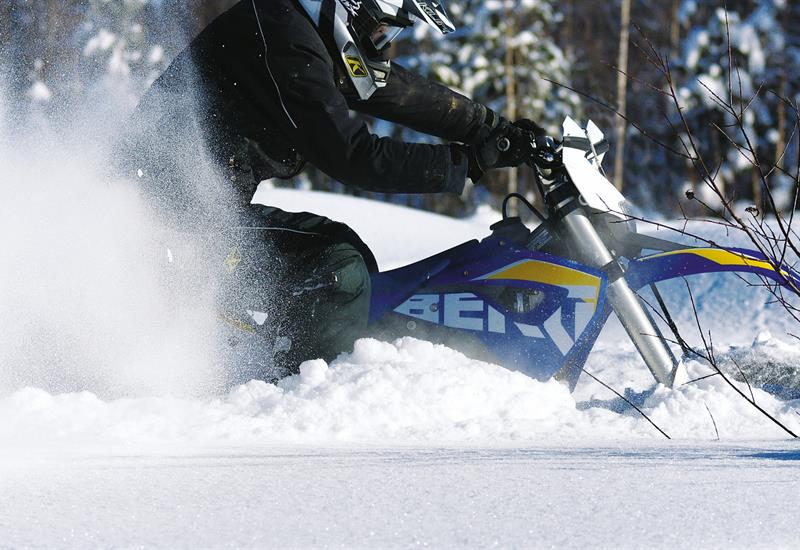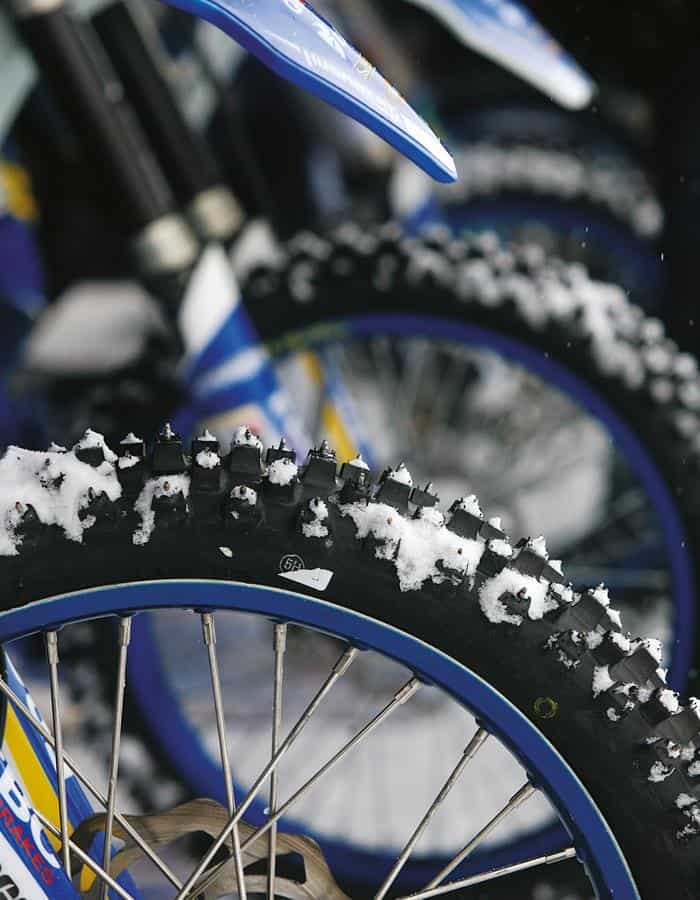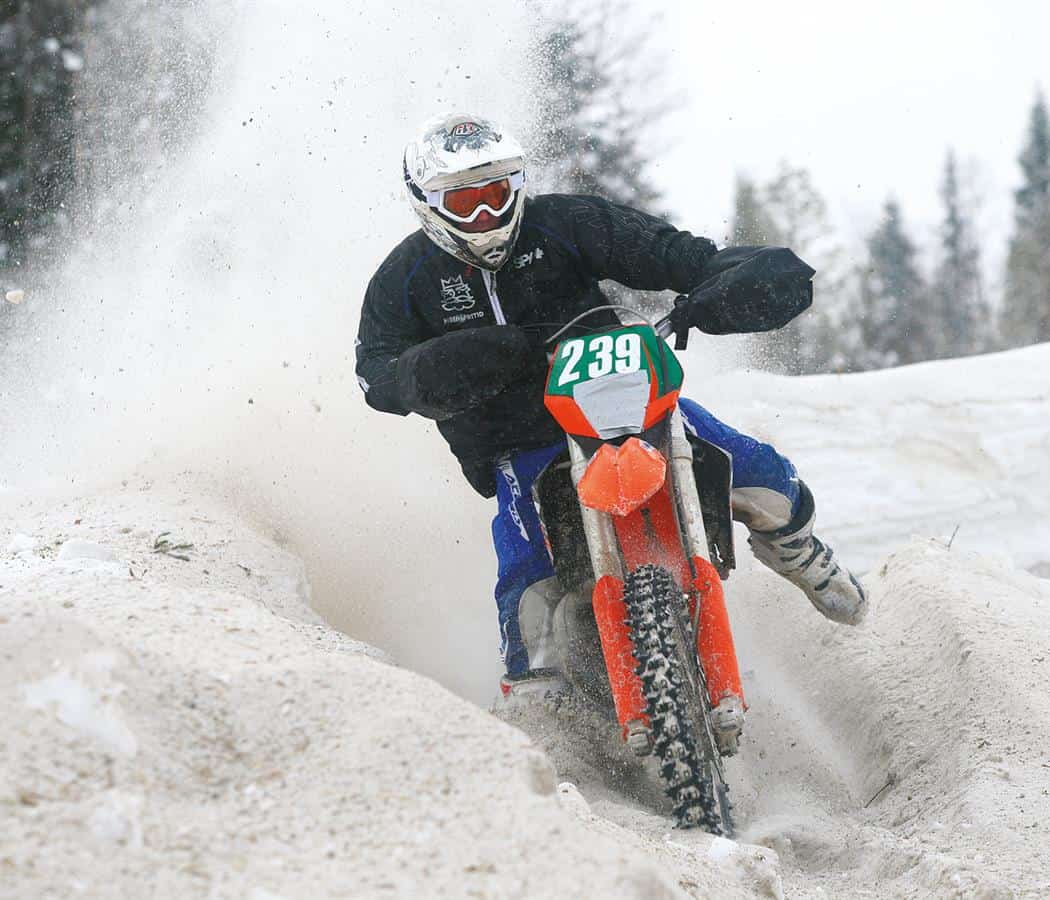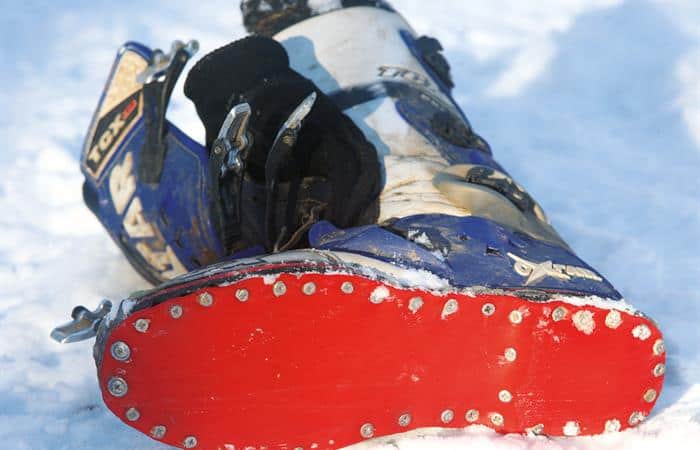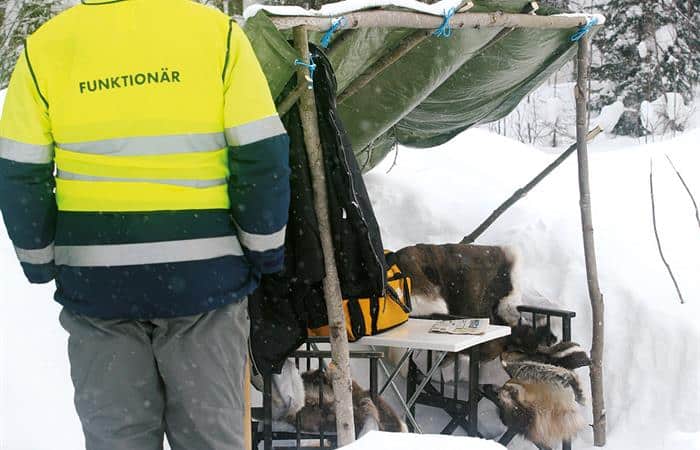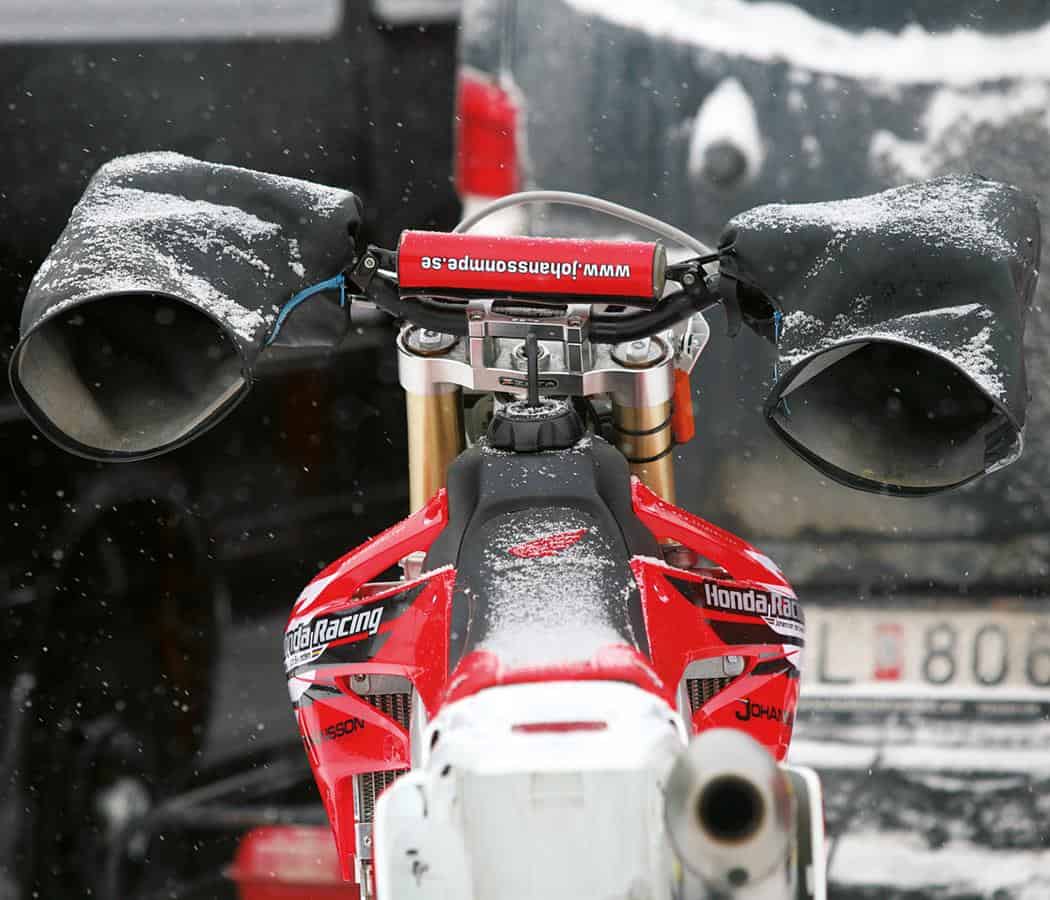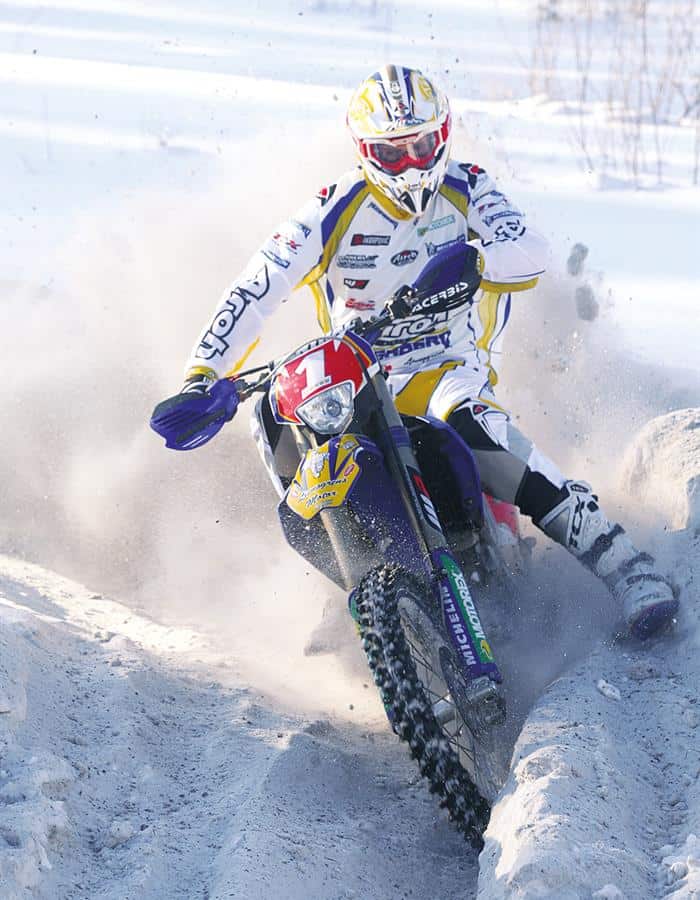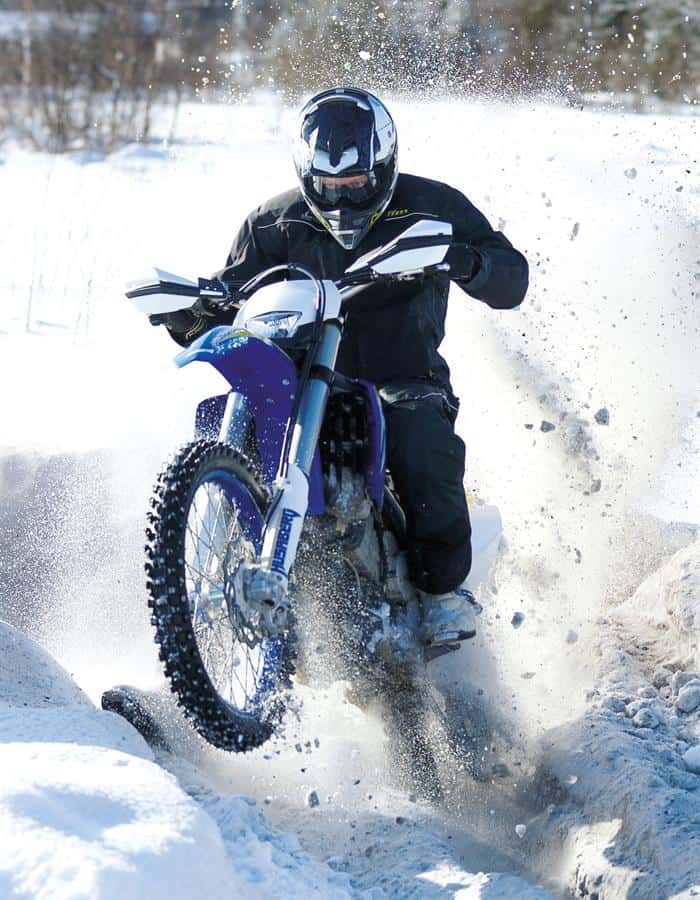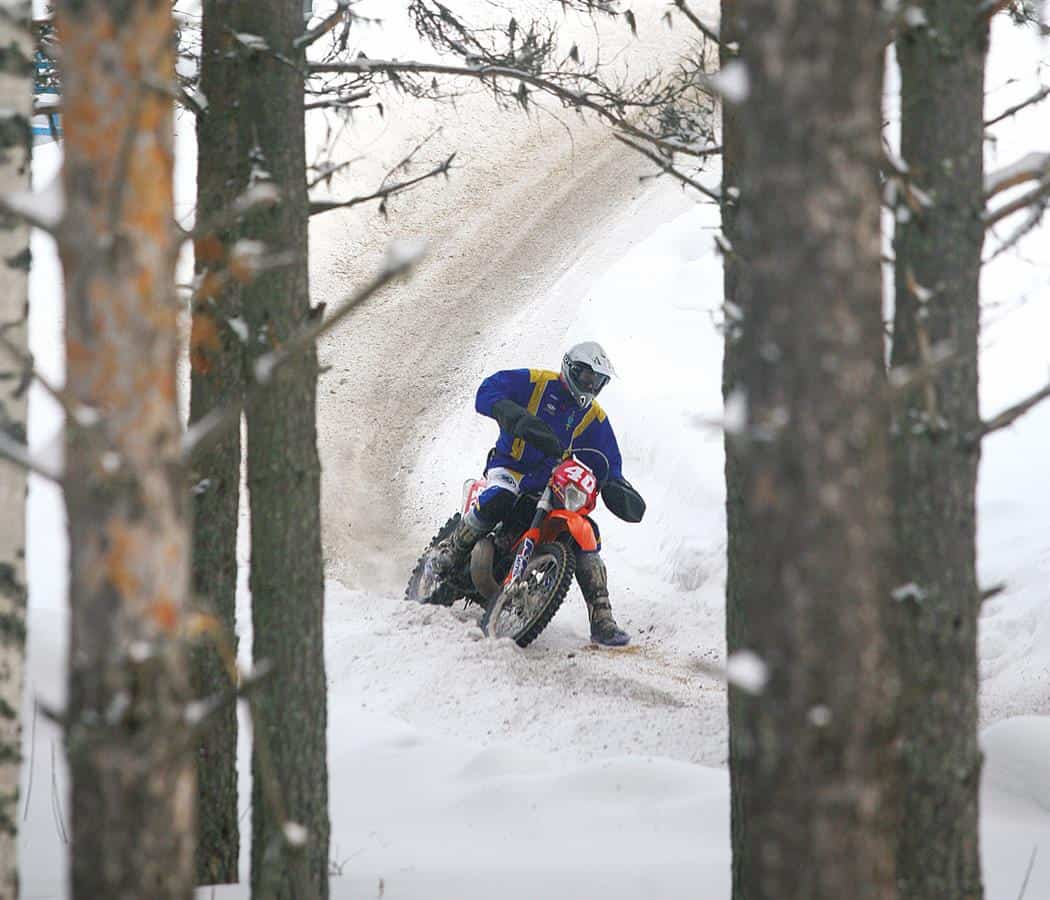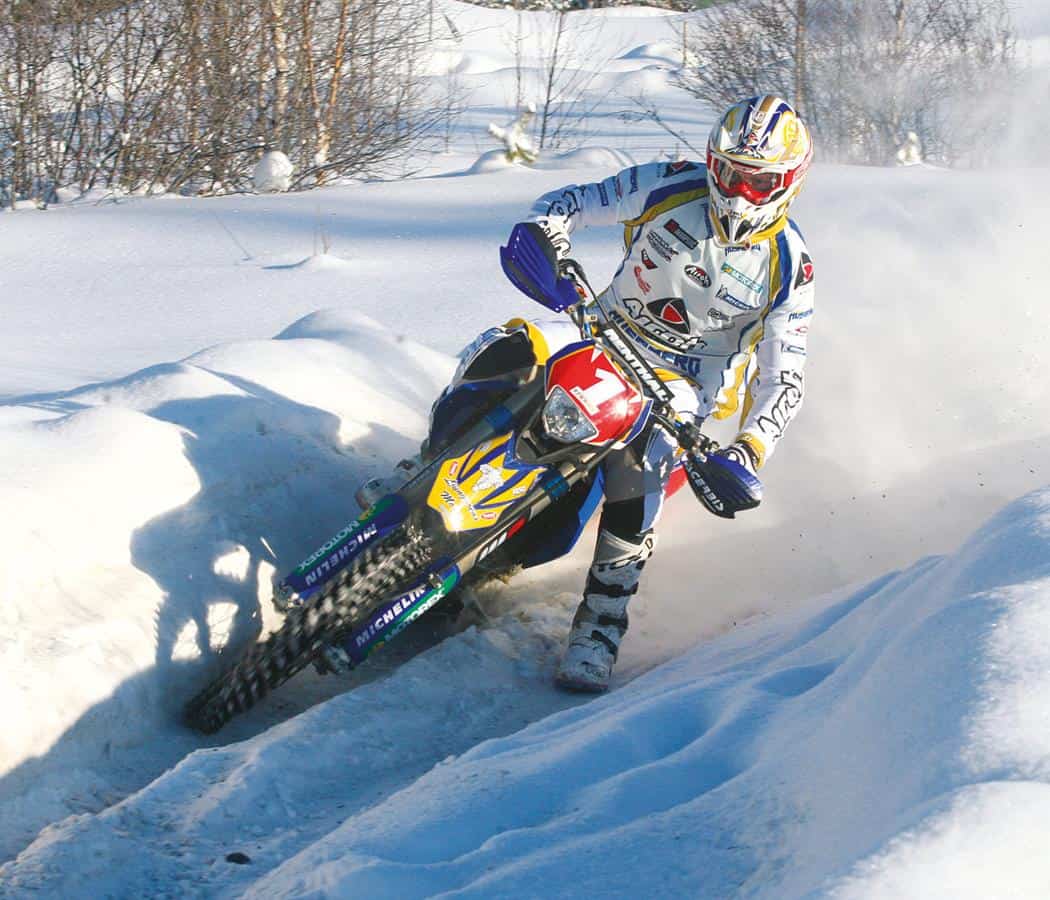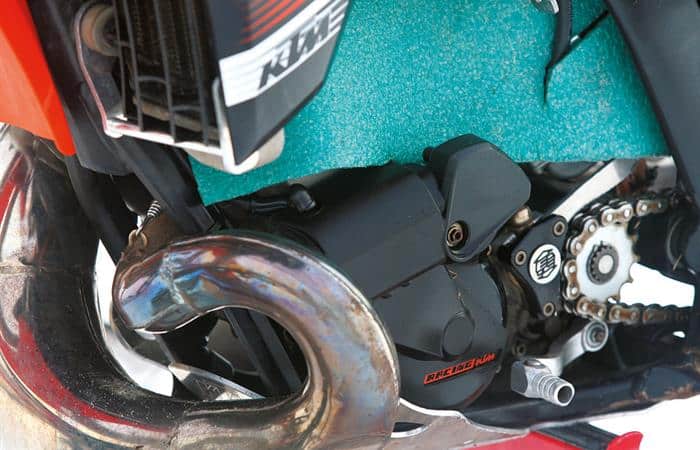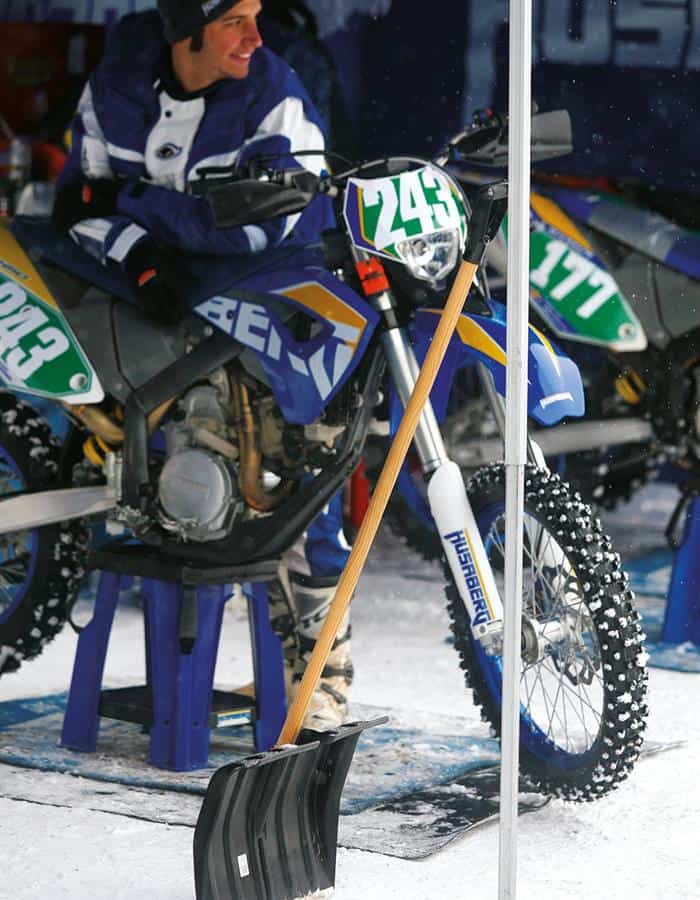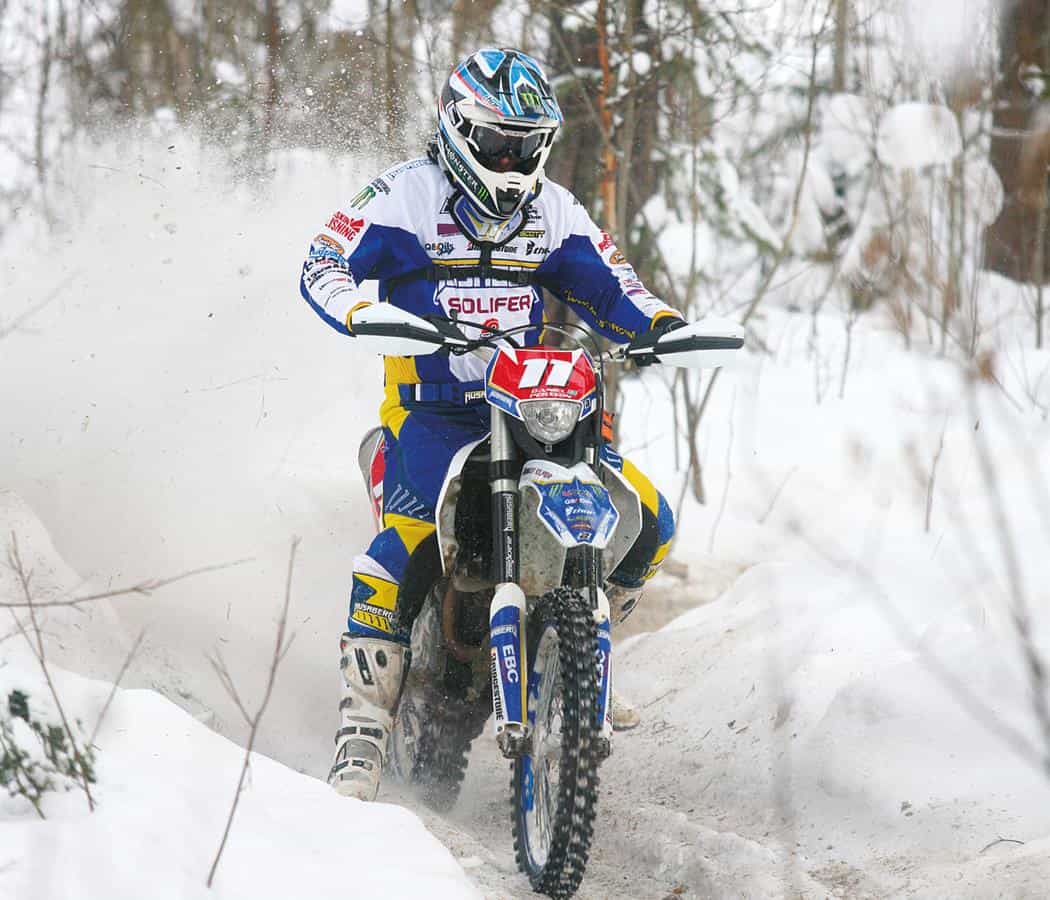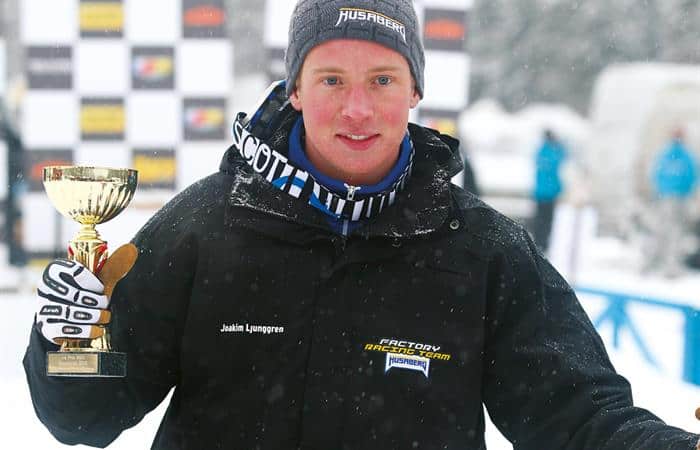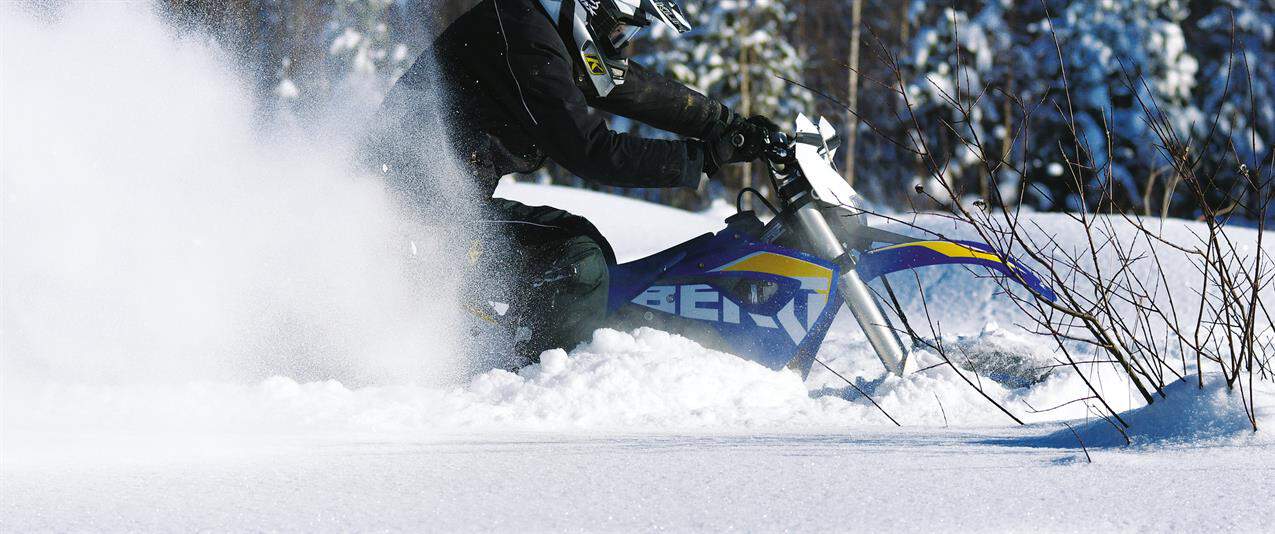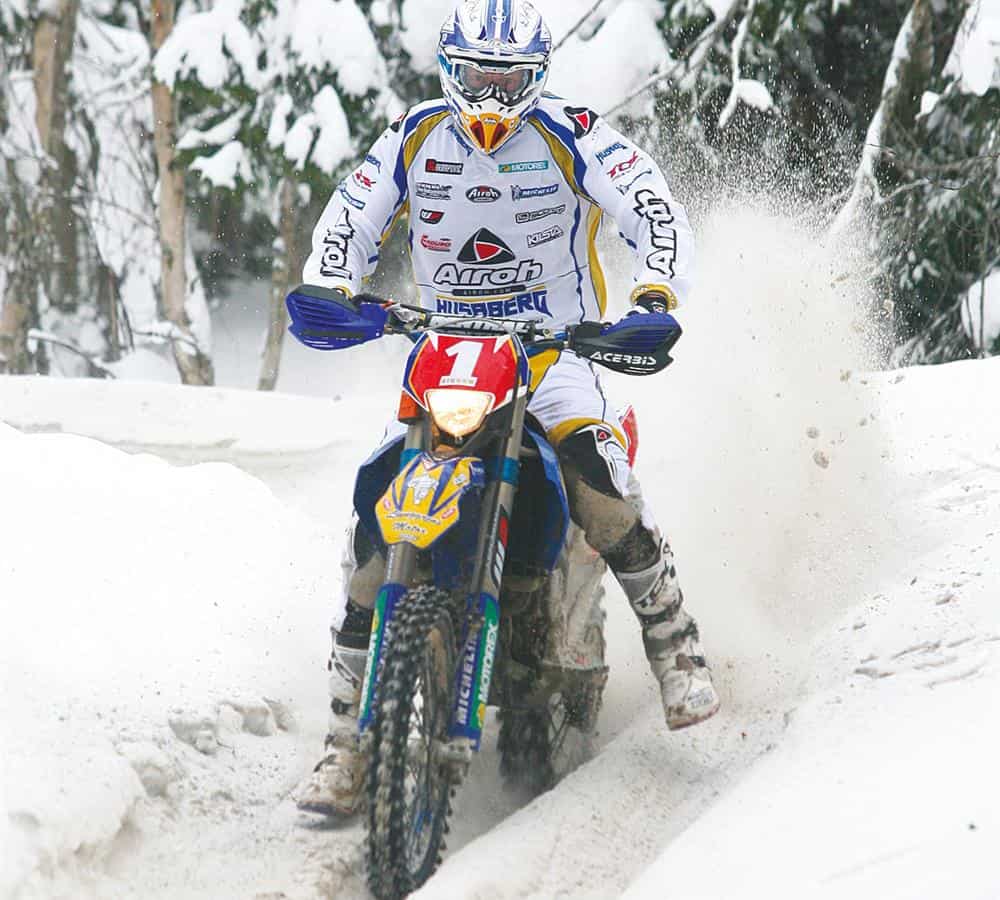SWEDISH SNOW ENDURO
When the weather outside is frightful should we tuck ourselves away in front of the fire or get out there and race? Barni flew to Sweden to experience enduro racing in a winter wonderland. Let it snow! Let it snow! Let it snow!
The temperature readout on the timecheck’s multi-function clock is showing 5.5º. It’s wrong. Very wrong. Snow lays deep all around, icicles hang from the edges of vans and huts, and everyone in the paddock is wrapped-up in a bulky jackets and woolly hats, with their feet isolated from the frozen ground by chunky snowmobile boots. Now MINUS 5.5º, that sounds about right…
Snowed-In
It’s the first round of the Swedish Enduro Championship in the picturesque city of Östersund, pretty much halfway up the 1000-mile long country. The city’s perched on the edge of Sweden’s fifth largest lake, Storsjön, which at this time of year is covered with ice thick enough to drive on, and with many of the snow-capped buildings built in the almost fairy-tale National Romantic style, the whole area is picture-postcard beautiful.
When Husaberg invited us out to Sweden – partly to show us where the brand ‘comes from’, partly to watch the first round of the Swedish Enduro Championship, and partly to ride in some real winter conditions – it was the perfect opportunity to find out how to deal with the white fluffy stuff.
Ordinarily, at the first signs of snow the UK grinds to a halt. The transport infrastructure falls apart, people start panic buying, and race organisers are forced to cancel events because no-one can get to them. But what if the kind of snowfall we’ve seen over the past two winters is set to become a regular feature of the darker months. What if British winters are once again going to be plagued by weeks of snow and ice? We’re going to have to learn how to deal with it, and, quite frankly, man-the-hell-up!
Obviously the Swedes are masters of dealing with snow. They simply slap a set of snow tyres on the car and drive around as per usual. And there’s no salting of the roads. The pavements are gritted but it’s not sodium chloride. It’s grit, as in ‘small stones’. And although the first round of their enduro championship is the only one to be run in snow (and not overly popular because of this) everyone seems to take it in their stride, with heated awnings and shovels to clear their pit. It’s just part of life…
Snow Men
The snow lies on the ground like a thick dusting of icing sugar, masking holes and hedgerows in one big amorphous wave of white. Ultra-fine powder; it’s nothing like the stuff we get in the UK, and its icy make-up means that it doesn’t really pack down. In short, it’s crap for making snowballs!
The paddock’s been snow-ploughed clear, and awnings are arranged in regimented rows. There’s a rally-style start ramp so that spectators can see the riders away, live-timing screens constantly scrolling through special test times, and a PA system you can actually hear clearly. Not that I could understand a single word of what was being broadcast over it..!
Alongside WEC-regular Ljunggren there are some other big names present. Long-time Husaberg pilot Björne Carlsson is there on his new Kawasaki and seven-time world champion Anders Eriksson is riding a YZ250 four-stroke. That’s some pretty stiff competition, though right from the start it’s clear that Ljunggren’s got it in hand…
Watching the timing screens hanging under an awning at the startline, the young Husaberg teamster steadily pulls out a lead over the rest of the entry. So it’s time to get out on the course and see what snow enduros are all about…
Two of the event’s four special tests are situated next to each other at one end of the paddock, divided by an access track. Which means it’s easy to catch the top guys as they go straight from the enduro test on the right into the extreme test on the left.
The red number one plate of Ljunggren streaks past, though I almost miss the blue ‘n’ yellow Berg as the rider’s style doesn’t look befitting a world champion – he’s feet-down almost everywhere. Then a few more riders run through the sinuous, wooded and rutted enduro test and I realise that it’s a technique everyone adopts. Why? Well that we’d find out the following day. But for now there was more riding to watch. In fact, there was A LOT more action to see…
Snow Storm
Six hours on a bike around a freezing forest course sounds like torture. And it’s even worse when you consider that the four separate special tests are each ridden four times. That’s four laps of the course and 16, yes sixteen, special tests to ride!
So whilst the top riders are out in the woods on a long check, we take the opportunity to get ahead of them and drive up to the ‘motocross’ test to see some high-speed action.
Located at the local motorsports complex, the test doesn’t appear to use any of the facility’s MX track itself – not that you can really tell what’s under all that snow. Instead, we’re told, it loops around a rallycross circuit before running out into the land on the perimeter and back towards the start. In contrast to the rutted forest tracks of the other tests, this one’s a little more open and gives riders the chance to let it hang out and really open up the bikes down the long straights. However, rutted berms have formed on many of the tight turns and there are even sections where they’re battling through deep snow mid-corner.
Naturally, the quick riders make it look very easy. There seems to be a huge amount of grip even when you can hear the studded tyres scraping across the icy ground, and as the bikes slam into berms, or the snow piled high at the edge of the track, powdery roost is thrown high, hanging in the air like dust rather than splattering the scenery.
Back in the paddock Joakim’s in for refuelling and looks calm and relaxed. ‘The course isn’t technically hard’, he reports, ‘just physical. You’re sat down all the time.’ Meanwhile team boss and Husaberg originator Thomas Gustavsson gives the bike a thorough check-over, removing ice built up around the wheels and chassis with a plastic scraper and de-icer fluid, before blowing loose snow off with compressed air. With plenty of time to spare, Joakim heads out for his last runs through the enduro and extreme tests.
Despite a trip over the bars whilst trying to double a log section on the extreme test Joakim still dominates the race. Almost five minutes separate him and second-placed Niklas Gustafsson on an E1-class Honda. The closest 450 is Björne Carlsson’s KX-F, some seven-and-a-half minutes back in fifth overall.
As the top three riders in each category collect their trophies and slip ‘n’ slither their way onto the podium snowmobiles scoot past carrying bikes abandoned out on the course. The cold’s setting in and I realise I can no longer feel my feet. Thankfully, this being Sweden, a sauna is never too far away…
Snow Globe
After days of dull grey skies the morning brings with it a shining sun. The air is notably crisper than before but somehow it doesn’t feel the -10 degrees we know it to be. I guess it’s the fact that everyone is eager to get riding at what has to be the most picturesque practice track I’ve ever seen. Bordered by tall, dark conifers on every side, the track curves through terrain blanketed in fender-deep snow. And where the sun catches the ice crystals it glitters brighter than a Tiffany’s window display.
After such a physical day’s riding Joakim looks surprisingly fresh. ‘I’ve been doing this since I was five’, he explains. ‘I’ve got a pain in the ass from sitting down all day but otherwise I’m fine.’ The affable Swede isn’t prone to boasting, he’s simply being honest with us. There’s a collective look of amazement from the assembled riders… We know we’d all be virtually crippled by six hours of riding in such conditions – two of which were at special test pace!
Kitting up for riding brings with it a dilemma. It’s well below freezing, so I know I’m going to need some warm layers, but then it’s going to be hard work. So I opt for nothing more snug than a base layer, regular riding pants, and a jacket over a race shirt, and head outside, where a full complement of Bergs – a 390, a 450, a 570 and an FX450 cross country racer – await.
Snow has the fantastic ability to make awesome riders look almost like total newbies (so god help me…). It’s not that they make it look like hard work – because if there’s one thing that top riders do is make everything look effortless – it’s that foot-down riding technique. Always sat down on the saddle, the style’s to always have one foot skimming the ground. Why? We’ll let Joakim answer that. ‘It makes it easier to control the bike, as you’re following one line’, he explains. ‘You need to let the bike go where it wants. Be light with your feet, don’t put any weight through them. And try not to do this [he mimes ‘Crazy Legs Crane’ style paddling].’ There’s more to it than simply sitting down and putting your feet on the ground though. ‘Get forward in the seat and pull a high gear,’ suggests Joakim. ‘Don’t be on/off with the gas, hold the throttle open and use it smoothly. Try to keep your weight off the seat on the rough and ‘swallow’ the bumps.’
Obviously there are certain areas of the bike – such as the tyres – which are specially adapted for snow. But what about the rest of the set-up? ‘Riding in snow is more about technique than set-up. I use a little more rebound damping as I’m sat down all the time but otherwise it’s exactly the same as the summer, albeit with the tape on the pegs (see box-out) and a very grippy seat.’ Joakim was one of a handful of riders not running a stepped seat or an improvised hump the previous day. Why was that? ‘Many guys like to have a seat bump to keep them forward on the bike but I like to be able to move around on the seat. And then a bump’s not so good. I prefer a good grippy seat.’
Now like any sane dirtbiker I have a real hatred for ruts, though as with most UK riders I’ve got pretty used to dealing with them. So the concept of following one line around the track is pretty straightforward – kinda like riding a wet Welsh forest event – though when there isn’t a rut to follow the snow’s deep enough to act like sand and drag the front-end wherever it wants. When that happens shutting-off is a big no-no.
On my fourth lap I hook a false neutral and topple over mid-turn, falling to the side of the track and into snow some three-feet deep. Pinned down by 120-kilos of icy Berg the air is silent except for my own laughter and then, suddenly, a rapidly approaching 450.
Thankfully Joakim spots the stricken bike early enough to stop, and we laugh at my predicament as I pull one leg out from under the bike and kick the Berg away from me. It’s the first of many pratfalls…
Soon Joakim’s seen enough of our efforts and calls us over to run through what we’re doing wrong. ‘Everyone looks stiff in the upper body. Relax’, he advises. ‘Be smooth, get forward and always have one foot down.’
There’s very little point trying to fight the front-end and with a very loose grip on the bars it does feel much easier to relax and let the bike track where the rut takes it. In the narrow confines of the track there simply isn’t the room to pick an alternative line. Sooner or later you’re gonna drop one wheel or another into that rut and then you’re back to square one. So just go with the flow.
You soon get used to riding with one foot down, and it becomes second-nature alternating between legs depending on where the course goes and which way the bike is deflected. Speed and momentum help greatly, though with any rutted course it takes some confidence to build up, and maintain a decent pace. At least the landing’s soft when it all goes wrong…
Snow Shoes
The previous day I’d noticed that most riders had a weird smooth sole screwed onto their boots, and the team had brought along three sets for us to try for ourselves. If you were trail riding in such conditions you’d probably want something that’d give you some purchase on packed-down snow and ice. But when you’re racing, well, far from giving grip the modified sole’s designed to add some slip.
So following a hearty lunch, I put on a pair of boots specially prepped with the slidey sole. When you look at the sole of a true MX boot (as opposed to a more dual purpose boot) then you can see how they’re designed to slide through the turns with very little tread to catch on the ground. But these ‘snow soles’ are something else. ‘What’s the sole made from?’ I ask Thomas. Rally car mudflaps is the improbable answer, though don’t think of those stiff ‘n’ chunky rubber items you used to see fitted to everyday cars, this material is thin and much more pliable. ‘It’s the same as they use on the strips hanging in factory doorways too,’ continues Thomas, and a mental image of industrial units all over Sweden with foot-shaped sections sliced from their doorways pops into my head.
Crucially the rubber is soft enough to grip the pegs yet slides very easily across the snow, and the difference it makes to the riding is extraordinary.
Either side of the rut were ‘ski-tracks’ formed by riders skimming their feet in the snow and that little slice of mudflap means your boots simply glide across the ground. I’d found that regular MX soles grabbed at patches of fresh snow, potentially (and painfully) twisting your knees, whilst this wasn’t a problem wearing modified boots. The confidence this gives is enormous and it allows you to concentrate on the course ahead. As Husaberg development engineer, Jens Elmvall, commented, ‘it makes as much of a difference as the tyres.’
Actually, it’s hard to tell just how much difference the studded tyres are making in the soft snow. Where you really notice the additional grip is when it packs down or turns icy. Then you can feel them clawing at the ground and really cutting into the surface. And, even messing about on the 570, it takes some effort to get the bike to step out of line.
Snow Doubt
Playing for the camera, I aim the Berg through some virgin snow, lean right back and gas it. Cutting through the landscape like a ship through arctic pack-ice, progress is slow thanks to the sheer amount of snow and there’s always the danger of hitting something buried beneath the surface. The stench of hot clutch plates fills the air, mixing with the steam rising from snow melting on a motor held wide open. Still we’re doing little more than 10mph.
Get the bike stuck, or wedge it on the firm banks of snow piled trackside, and it’s a real slog to extract it. My goggles steam up from a mix of exertion and, well, steam, and as soon as I remove them the condensation on the lens freezes! They won’t wipe clean – I have to scrape the ice off the inside before drying them with a cloth.
As the track becomes more and more worn holes start to appear on the way out of the turns, often camouflaged by a light covering of snow. Where we’ve been getting on the gas the rear wheels have dug out the snow and dropping the front-end into the subsequent dip really unsettles the bike. On the whole they’re easily spotted, as the tyres have scooped down through to the soil and tainted the whitewashed setting with patches of coffee-coloured dirt, and when you know the holes are there you can adapt your speed, your body positioning and, to a certain extent, your line. When they take you by surprise though, it’s a complete lottery as to whether you get thrown forward or bucked out of the seat. I can’t imagine what it’d be like once a full race entry had been through.
Snow Drift
Messing about in the snow is pretty simple, and when it’s not very deep you can drift about having a right old hoot. But racing in it is something very different indeed, oh yes. Don’t expect to be arcing graceful turns with the back-end stepped out in a spectacular slide, or charging about feet-up in a white winter wonderland. Because most snow enduros seem to be about sitting down on the seat, getting in a rut, and following it. It’s a hard slog. So pray that the winters start getting warmer and we don’t have to grow accustomed to even more rut-filled events after all. They might be picturesque but they’d be bloody hard work. Though we can take comfort in one thing: I can’t think of a single British enduro that’d put us through 16 special tests in one day… Those crazy Swedes!
Thanks: Huge thanks to Joakim Ljunggren, Thomas Gustavsson, Jens Elmvall, Martin Wabnegger and all of the Husaberg team for making us welcome and for all of their help. And also to Ross Walker at KTM UK. Cheers guys!
Snow Mobile
Do you laugh at your ‘cissy’ mates who’ve fitted heated grips to their dirtbike? Then you, sir, are an eejit. Because having warm hands in freezing temperatures makes riding that bit more enjoyable. And the Swedes take things a little bit further than using heated grips – they fit bar muffs to their enduro bikes! Yep, in the UK they’re the preserve of courier’d CX500s, but they’re the ‘hot-ticket’ for sub-zero racing. The muffs not only keep the worst of the cold and snow from freezing your digits, but also allow riders to wear regular dirtbike gloves and therefore retain plenty of feel on the bars and levers.
Those who don’t run muffs employ another technique to help keep their fingers that little bit warmer behind the handguards – they tape up their levers with insulating tape so that they don’t have to touch the cold metal levers.
Elsewhere on the bike, duct tape is employed to great effect – wrapped around the pegs and the end of the rear brake lever so that they don’t turn into huge balls of ice. And a number of riders also tape a large ‘hump’ onto the rear of their seat to force them forward in the saddle – after all, they are riding ruts all day long.
Two-stroke riders often tape up part of their rads in order to maintain some heat in the motor, and also ‘blank-off’ the sides of the engine in order to prevent snow and ice from building up around the barrel and carb.
Studded tyres are de rigueur, with each knobble featuring a half-inch metal stud. We’ve seen such tyres on sale from Scandinavian brand, Trelleborg, though a number of teams in the paddock were running more mainstream rubber brands. So which poor sap gets the task of screwing in all of those studs? Well as it turns out, in Scandinavia you can buy tyres we’d be familiar with in the UK all kitted-out with studs. The market demands it so they supply them!

